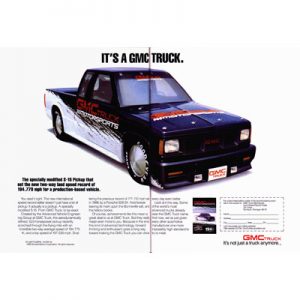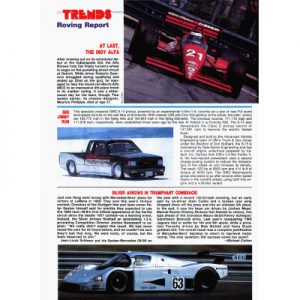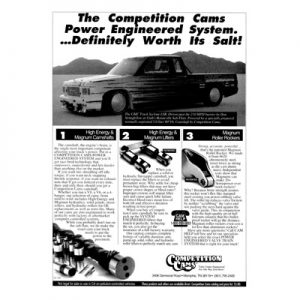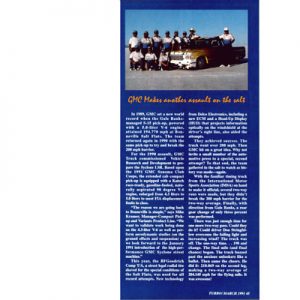Popular Mechanics
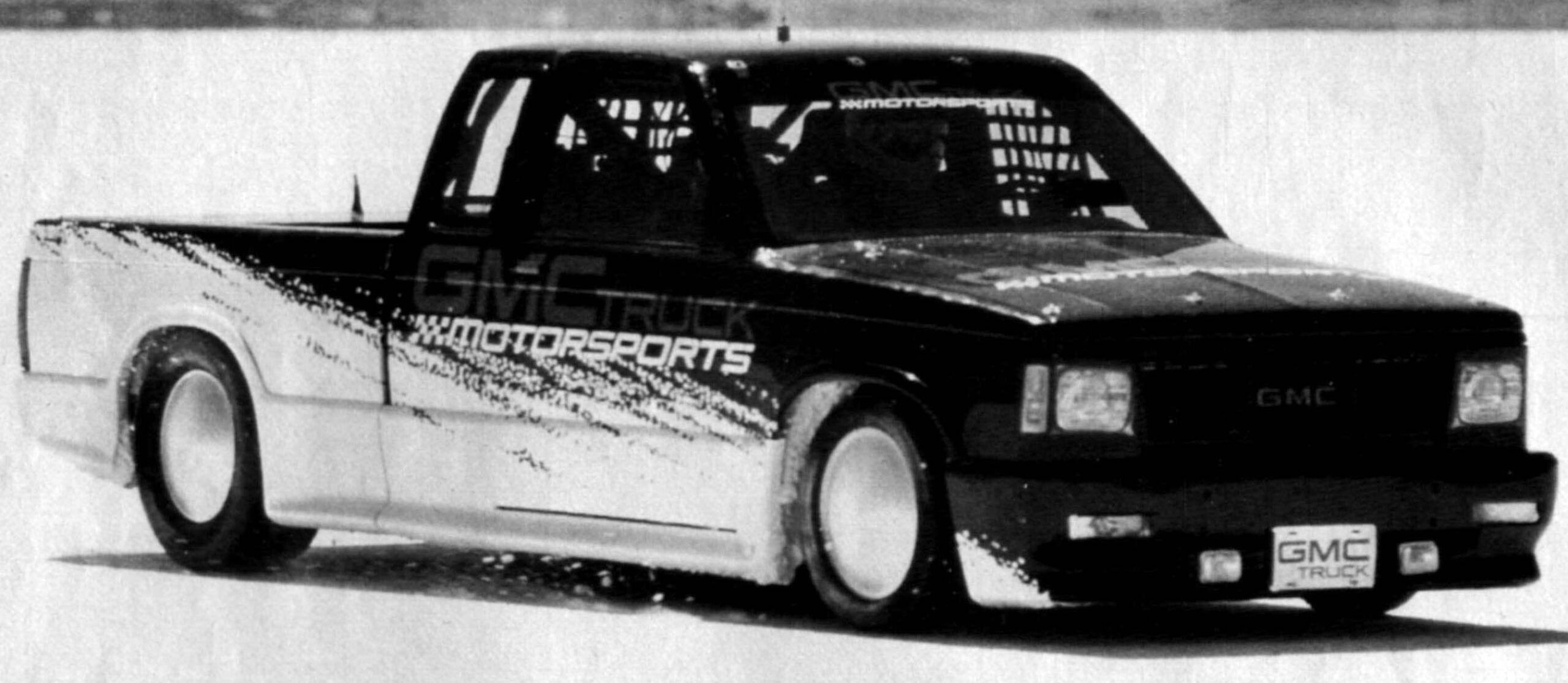
BY LEN FRANK
Driving a modified GMC 5-15 Jimmy Club Coupe, Don Stringfellow broke a Bonneville speed record previously held by a Porsche 928S 4.
On August 7, 19869 the late Al Holbert drove a new Porsche 928S 4 complete with stereo cassette deck and catalytic converter from Porsche’s headquarters in Reno, Nevada, to the Bonneville Salt Flats just east of Wendover, Utah.
There he drove 171.926 mph through the kilometer, 176.110 through the mile, a 2- way average that established new world FIA-sanctioned records for Category A, Group II, Class 9 vehicles.
If we are to believe the TV commercials, Holbert did it while listening to classical music on the cassette player –Wagner’s “Ride of the Valkyries” would have been appropriate. Then, the story goes, he drove back to Reno.
On the afternoon of July 20, 1989, a GMC S-15 Club Coupe (GMC’s version of the extended cab pickup), driven by Don Stringfellow, went down the salt and back at 194.843 mph for the kilometer, 194.770 for the mile and took the record.
Since straight-line speed is a function of horsepower trying to force a vehicle through the air and drag it over the ground, increasing horsepower, decreasing the vehicle’s frontal area, reducing coefficient of drag (Cd), and/or reducing rolling resistance and chassis friction, makes the vehicle go faster.
The most successful efforts, of course, include all of the above, and it was all of them that GMC’s Advanced Vehicle Engineering group (AVE) applied to the S-15.
Air drag is the hard one —power requirement goes up as a square of the speed. The stock S-15 has a top speed of about 100, so to get it to go almost 200 takes four times the power. But if you reduce air drag, requirements drop off by that same square. The rules require a stock body. The Club Coupe has less drag than short cab trucks and that small advantage was aided by some of the SIT package trim pieces primarily the front spoiler. Major reductions in drag came from lowering and changes in rake—slightly nose down (achieved by Bell Tech dropped spindles)—and in taking care of the air that spills over and around the cab.
A tonneau box at the rear of the bed helps take care of that spilled air. It reduces drag more than a full tonneau cover, or running with the tailgate down, and it hides some interesting hardware. The result, determined in GM’s own wind tunnel, reduces drag nearly 40 percent from stock. Cd is now 0.31, down from 0.49, and frontal area is slightly reduced by the lowering.
Rolling resistance was cut by removing the front brakes entirely, replacing the transmission with a Weissrnan racing 5-speed, the rear axle with one from Strange Engineering, and connecting the two with a carbon-fiber drive-shaft. The trans has an almost infinite number of quick-change ratio combinations both trans and axle have less internal drag (and more noise) than stock. Driveshaft U-joint angles were kept as straight as possible and front toe is at the minimum for rolling drag.
The stock GMC 4.3-liter V6 (160 hp at 4000 rpm) has been replaced by a racing version of same built by Katech, best known for its GM-based road racing engines. The engine was developed by AVE and Katech, and begins with the cast-iron “Bowtie” heavy-duty block. Unlike the even-fire production engine, the Bonneville version uses a Moldex odd-fire crank, with Oliver steel billet rods connected to Diamond Racing Product pistons. Heads are Brodix aluminum compression is up to 12.6:1 (stock 9.3:1). Both bore and stroke have been increased and displacement is up from 262 Cu. in./4300 cc to 301/4939.
A steel billet roller cam setup by Competition Cams is combined with Iskenderian lifters, Falconer needle bearing rockers, a Katech rev-kit and titanium valves all standard hot-rod stuff.
Intake is by a road race-based Kinsler fuel-injection manifold and throttle assembly, combined with AC Rochester injectors, fuel pump and fuel regulator. Ignition is a Delco CD unit, and engine management is by a Delco Generation II ECM, monitoring throttle position, intake plenum, air temp, coolant temp, crank position and engine speed somewhat simpler than its passenger car application. It sets ignition timing, injection timing and injection volume.
Bonneville is over 4000 ft. elevation, ambient temperatures are high and both conditions are the death of horsepower. Some of it is recovered by a system that starts with an ice chest hidden under the tonneau box in the rear —a pair of electric bait pumps circulate ice water through a pair of converted Harrison a/c evaporators mounted behind the grille. Intake air is drawn through them, cooled and made more dense, fooling the engine into thinking it’s running at lower altitude.
On the record run, underhood air temp was 116° F, while intake air was lowered to 86° F. Cooling water temp went from a chilly 42° to a tepid 64°—the system works. The result of this combination of standard hot-rod hardware and sophisticated electronic control and induction is a reliable 523 hp at 6800 rpm, and 414 lb.-ft. of torque at 6400.
A second engine has been built to tackle SCTA national truck records, similar in most respects to the 5-liter but displacing 4.26/260 to fit the class. The smaller engine is rated at 470 hp at 7800 rpm.
Skinny (23x5x15) Goodyear Drag Front Runners are teamed with Stock Car Specials in the rear, Cragar wheels on the front, Weld wheels rear, covered by Moon discs to lower drag.
All factors that control state of tune, engine condition, wheelspin, speed, weather conditions, aerodynamic lift, are monitored and relayed back to a special telemetry van so that corrections can be made, information gathered and analyzed, and disasters averted. Ironically, the system failed to work on the record runs. A magnetic field generated by the salt itself was suspect, and AVE/Delco will look into better shielding for the future. A similar system was developed by Delco/Powell Motorsports and has worked successfully for some years.
Although pleased with the record, GMC still has its eyes on the 200-mph mark for the truck. But even if that goal is never achieved, this is one Jimmy that can legitimately claim membership in the supercar club.

